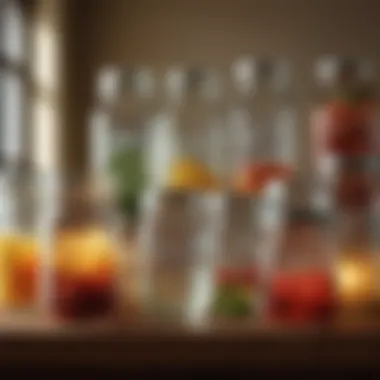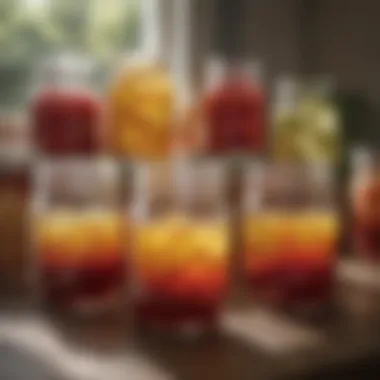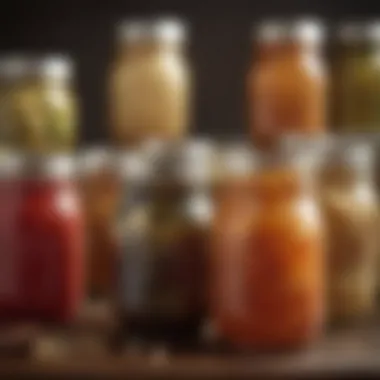Mason Jars: Culinary Versatility Beyond Storage


Intro
Mason jars, a staple in kitchens, go beyond their original purpose of food storage. Their adaptable nature makes them invaluable in various culinary practices. Understanding their versatility can enhance both the approach and enjoyment of cooking. This discussion covers their historical significance and wide-ranging uses in modern kitchens.
The enduring relevance of mason jars lies in their ability to merge function with creativity. They serve not only practical roles in food preservation but also artistic expressions for presentation and serving. This exploration aims to provide insight into recipes, preservation techniques, and innovative uses that every culinary enthusiast might find beneficial.
Recipe Overview
A prime example of mason jar versatility is their use in layered salads. This dish is not only visually appealing but also maintains freshness longer due to its unique storage method.
Dish Description
Layered salad in mason jars offers a convenient way to prepare meals ahead of time. Each layer can consist of varied ingredients, providing a balanced and nutritious option for lunch or dinner.
Ingredients List
- Fresh mixed greens
- Cherry tomatoes
- Cucumber, diced
- Bell pepper, diced
- Chicken breast, cooked and cubed
- Olive oil
- Balsamic vinegar
- Salt and pepper to taste
Step-by-Step Instructions
Preparation Steps
- Start by washing all fresh produce thoroughly.
- Dice the cucumber and bell pepper into bite-sized pieces.
- If using raw chicken, cook it thoroughly on medium heat, ensuring it is fully cooked before cubing.
Cooking Process
- In a mason jar, begin layering ingredients. Place the dressing at the bottom to prevent the greens from wilting.
- Add a layer of cherry tomatoes followed by cucumber and bell pepper.
- Continue with the cooked chicken and finish with mixed greens on top.
- Seal the jar tightly and store in the refrigerator. This dish can last up to five days while maintaining freshness.
"Utilizing mason jars for layered salads not only conserves space but also keeps ingredients separated until serving."
This method illustrates how mason jars can perfectly blend practicality with creativity in meal preparation.
The Historical Significance of Mason Jars
Mason jars hold a notable place in culinary history due to their functional design and innovative purpose. Understanding their historical significance helps appreciate their continued relevance in modern cooking. These jars are not just containers; they symbolize a shift in food preservation practices and reflect changes in societal needs. This section discusses the origins, evolution, and cultural impact of mason jars, showcasing their multifaceted roles beyond mere storage.
Origins of the Mason Jar
The mason jar was invented in the mid-19th century by John Landis Mason. The original design emerged in 1858 as a solution for preserving food more efficiently. Prior to this, people relied heavily on less effective storage methods like crocks or simple glass bottles, which did not seal tightly. The mason jar featured a threaded neck and a screw-on lid, allowing for improved airtight seals. This innovation enabled home cooks to store fruits and vegetables, extending their shelf life significantly. The canning method pioneered with mason jars transformed how families managed food resources, particularly in a time when seasonal availability was critical.
Evolution Over Time
Over the decades, the mason jar has evolved in several ways. Initially made of clear glass, modern variants include colored glass and even decorative designs. Their functional design has undergone refinements, yet the basic principles remain unchanged. In the early 20th century, mass production made these jars more accessible, accompanying the rise of home canning movements. As domestic canning became popular, companies like Ball and Kerr emerged, producing jars that have become household names. Today, mason jars are not solely for canning; they are embraced for meal prep, DIY projects, and even trendy drinkware.
Cultural Impact of Mason Jars
The cultural significance of mason jars extends far beyond their practical uses. During times of war and economic hardship, such as the Great Depression, these jars became symbols of frugality and self-sufficiency. Many families learned to preserve their harvests, fostering a connection to the land and their food sources. In recent years, mason jars have also found a place in the artisanal and eco-friendly movements. They are seen as staples for reducing plastic waste, aligning with a growing awareness of sustainability in culinary practices. Moreover, their aesthetic appeal has made them a popular choice for restaurant presentations and home decor.
"Mason jars are emblematic of a return to simple, sustainable practices in the culinary world."


Primary Uses of Mason Jars in the Kitchen
Mason jars have transcended their original purpose of food preservation to become essential tools in modern kitchens. Understanding the primary uses of mason jars highlights their value, versatility, and practicality in daily culinary practices. With their durable construction and airtight seals, these jars provide efficient solutions for food storage, preparation, and presentation. Emphasizing convenience and aesthetics, mason jars support home cooks and food enthusiasts alike in elevating their culinary experiences.
Food Storage Solutions
Food storage is one of the most significant roles of mason jars. They allow for effective preservation of a variety of ingredients, from dry goods such as rice, beans, and spices to perishable items like fruits and sauces. The transparent glass allows easy visibility of contents, making it simple to identify what is inside, thus minimizing waste.
When storing items, important factors include:
- Airtight Seal: This helps prevent spoilage and extends the shelf life of food. It keeps moisture and air out, reducing the risk of mold and staleness.
- Stackable Design: Mason jars can be stacked in cupboards, maximizing space efficiency. This is particularly useful in smaller kitchens with limited storage.
- Eco-Friendly Alternative: Using mason jars reduces reliance on plastic containers and wraps, aligning with sustainable practices in food storage.
Preparing and Transporting Meals
Mason jars are not simply for storage; they serve as practical vessels for preparing and transporting meals. Their solid structure allows for a variety of cooking techniques, such as layering ingredients for salads or incorporating dressings. This aspect is beneficial for meal prep enthusiasts, as meal assembly can be done in advance and stored for later use.
For on-the-go meals, mason jars are ideal. They are:
- Compact and Lightweight: Easy to carry in bags or lunchboxes, they provide a convenient way to take meals to work, school, or picnics.
- Portion Control: One jar can be used for one meal, helping people manage serving sizes effectively.
- Versatile: Jars can hold both solid and liquid components, such as soups, salads, overnight oats, or even desserts, maintaining freshness during transport.
Creative Recipe Containers
The versatility of mason jars extends into the culinary realm, serving as creative containers for various recipes. This application enhances the presentation of food while allowing for a fun and engaging way to serve dishes.
Mason jars can be used for:
- Layered Dishes: Recipes like parfaits or layered dips can be visually stunning in mason jars, offering an elegant touch to gatherings.
- Gift Ideas: Filled with dry ingredients for cookies or other treats, they can serve as charming gifts, combining presentation with functionality.
- Customizable: They can be easily decorated with labels or ribbons, adapting to themes or special occasions, making them suitable for events.
"Mason jars are not only practical but also add a jarring twist to presentation, making food appealing before it is even tasted."
In summary, the primary uses of mason jars in the kitchen reveal their multifaceted nature. From storage solutions to meal prepping and creative recipe containers, mason jars play a vital role in enhancing both the preparation and enjoyment of food.
Canning and Preservation Techniques
Canning and preservation techniques using mason jars play a crucial role in contemporary culinary practices. Understanding these methods is vital for those who wish to harness the full potential of their culinary ingredients. The ability to extend the shelf life of various foods not only reduces waste but also allows cooks to enjoy seasonal ingredients year-round. Moreover, the precision of these methods ensures the nutritional integrity and flavor of preserved foods.
Overview of Canning Methods
Canning generally involves sealing food in airtight containers and then heating them to eliminate spoilage-causing microorganisms. This can be done using two primary methods: water bath canning and pressure canning.
- Water bath canning is suitable for high-acid foods, such as fruits, jams, and pickles. In this method, jars filled with food are submerged in a boiling water bath, ensuring that the contents reach a temperature that effectively kills bacteria.
- Pressure canning, on the other hand, is necessary for low-acid foods like vegetables and meats. This method uses a pressure canner to achieve higher temperatures that water bath canning cannot. It is critical for maintaining food safety when preserving these types of foods.
Understanding these methods enables cooks to select the appropriate technique based on the type of food they wish to preserve, ensuring both safety and quality.
Safety Protocols for Canning
Safety is paramount when it comes to canning. Failing to follow proper protocols can lead to foodborne illnesses, particularly with low-acid foods that are more susceptible to contamination.
To ensure safety, adhere to the following practices:
- Use tested recipes from reputable sources. These recipes are formulated to provide specific steps and times necessary for safe canning.
- Check jars for cracks or chips before use. Damaged jars can compromise the seal, leading to spoilage.
- Adjust for altitude. High altitudes require changes in processing times and pressure settings. Knowing your location’s altitude is necessary for effective canning.
- Process jars for the recommended time. This ensures all microorganisms are destroyed, making the food safe for consumption.
- Store canned goods in a cool, dark place. This prevents temperature fluctuations that can spoil the jars.


Following these protocols not only protects health but also enhances preserving efforts.
Popular Preserved Foods
Mason jars can preserve a vast array of foods, catering to various tastes and preferences. Some popular options include:
- Fruits such as peaches, pears, and apples are often canned as whole pieces, slices, or in syrup.
- Vegetables like green beans, corn, and tomatoes are also commonly preserved. They can be packed raw or blanched before canning.
- Jams and jellies provide delightful spreads. These allow for creativity in flavor combinations, using seasonal or exotic fruits.
- Pickles, ranging from cucumbers to more adventurous options like carrots or radishes, add a tangy zest to meals.
In summary, mastering canning and preservation techniques allows food lovers to explore the full spectrum of culinary possibilities that mason jars offer. These practices are essential not just for extending the usability of ingredients but also for enhancing the flavors and experiences in everyday cooking.
Innovative Culinary Uses of Mason Jars
Mason jars are not only functional but also offer a creative canvas for culinary enthusiasts. Their glass structure provides visibility, making it easier for both the cook and guests to appreciate the aesthetics of the food. These jars can elevate ordinary meals into visually appealing presentations. Moreover, they can be used for various innovative applications that maximize both convenience and creativity in cooking and presentation.
Salad Jars for Meal Prep
Salad jars represent an efficient way to prepare and store salads for the week. By layering ingredients from the bottom up, starting with heavier items like dressing, followed by grains, then proteins, and finally vegetables, the salad remains fresh until you're ready to eat. This method not only preserves the crispness of greens but also makes it easy to transport salads without risk of sogginess.
Considerations when utilizing this method include:
- Ingredient Selection: Choose robust ingredients that hold up well over time. Cherry tomatoes, bell peppers, and cucumbers are ideal for layering.
- Portion Sizes: Since Mason jars come in assorted sizes, choose your jar according to the portion you desire. Quart-size jars, for instance, can hold substantial salads.
This method not only helps in meal prep but also promotes healthier eating habits.
Dessert Jars and Layered Treats
Dessert jars can transform any simple dessert into an elegant display. Layering ingredients such as cake crumbs, whipped cream, and fresh fruits can create visually stunning treats that are easy to serve. Guests are often captivated by the layers, which provide a glimpse of the dessert within.
Benefits of utilizing Mason jars for desserts include:
- Convenience: They are easily stackable and can be prepared ahead of time, saving stress during gatherings.
- Personalization: Each jar can be tailored to individual tastes, allowing for unique combinations and flavors.
Ideas for desserts suitable for jar presentations might include trifle, cheesecake, or layered parfaits. These desserts not only taste good but also provide a creative avenue to showcase culinary skills.
Infused Flavors and Beverages
Infused drinks offer a fresh twist on beverages, and Mason jars are perfect for this purpose. You can create infused water, teas, or cocktails by adding fruits, herbs, or spices to a jar and letting them steep for several hours or overnight. The clear glass allows the vibrant colors of the ingredients to shine through.
When making infused beverages, consider these factors:
- Flavor Combinations: Explore recipes using various fruits and herbs. For example, lemon and mint, or cucumber and basil.
- Infusion Period: Depending on the intensity you desire, adjust the infusion time. Longer steeping tends to yield stronger flavors but can also lead to bitterness.
Mason jars provide not just creativity in flavor, but also an attractive way to serve infused beverages at social gatherings.
Using Mason jars creatively can not only enhance the aesthetics of food but also promote a healthier and more organized approach to meal preparation and serving.
Mason Jars in Food Presentation
Mason jars have gained recognition not just for their functional uses but also for their role in enhancing food presentation. Utilizing mason jars creates a unique dining experience that can elevate even the simplest of meals. The transparency of these jars allows for visual engagement with the meal, making it more appealing to the diner. This aspect is particularly vital in our visual-centric culture, where first impressions can significantly influence the enjoyment of food.
The ability to serve individual portions in mason jars caters to both aesthetic preference and practicality. Moreover, the jars are reusable and versatile, allowing for a wide array of presentations, from salads to desserts. They blend functionality with artistry, making them a staple in modern culinary practices.


Aesthetic Appeal in Dining
The aesthetic appeal of dining experiences can be greatly enhanced through the use of mason jars. Their clean lines and transparent body not only showcase the ingredients but can also enhance the overall theme of a meal. Food looks more vibrant and inviting when presented in a mason jar. The layered look in desserts, for instance, creates an eye-catching contrast of colors, textures, and flavors.
Many restaurants and home cooks use mason jars to create an intimate dining atmosphere. Whether it’s a casual family gathering or a fine dining event, mason jars can adapt easily to various themes. For example, using rustic or vintage-style jars can evoke a feeling of nostalgia, while sleek, modern jars contribute to a contemporary dining experience.
Benefits of Aesthetic Appeal in Dining:
- Enhances visual appetite
- Adds a unique touch to food presentation
- Easily adapts to different themes and occasions
- Encourages portion control in servings
Thematic Decor Uses
In addition to food presentation, mason jars serve as exceptional decorative elements. These jars can be tailored to fit the specific theme of an event or a restaurant. For instance, during festive seasons, mason jars can be filled with seasonal items like pine cones or small ornaments, further enhancing the application of decorative elements.
In casual settings, mason jars can be used as centerpieces on dinner tables. Filling them with fresh flowers, herbs, or fairy lights adds both charm and warmth to the dining experience. They can also be employed to create inviting displays for drinks or appetizers.
Considerations for Thematic Decor Uses:
- Choose appropriate sizes and styles of jars for the theme
- Fill jars with items that complement the overall aesthetic
- Ensure the presentation aligns with the seasonal or event theme
Utilizing mason jars for food presentation not only elevates the dining experience but also reflects a thoughtful approach to culinary art. This integration of functionality, design, and sustainability echoes the broader purpose of mason jars in modern kitchens.
Sustainability Aspects of Using Mason Jars
Sustainability has become a crucial topic in recent years. As consumers grow more concerned about environmental impact, various strategies emerge to mitigate our carbon footprint. Mason jars present a remarkable option for addressing sustainability in culinary practices. Their versatility needs to be highlighted, especially when we talk about reducing waste and promoting eco-friendly practices in the kitchen.
Reducing Plastic Waste
One of the primary issues with modern food storage is the excessive use of plastic. Single-use plastics are not just harmful to the environment; they also pose health risks with leaching chemicals. Using mason jars can significantly reduce the need for plastic containers. These glass jars can store a variety of items, from pantry staples to leftovers, thereby limiting the dependency on plastic bags and cling wraps.
Mason jars are durable and can be reused many times. This durability reduces overall waste. Studies have shown that switching to glass containers can decrease household plastic waste by up to 80%. This switch encourages individuals to rethink their storage choices, leading to sustainable habits that align with environmental values.
Eco-Friendly Storage Solutions
Mason jars are also excellent for storage solutions that promote sustainability. Their airtight lids help in preserving food freshness without the need for preservatives that synthetic products may contain. Using mason jars for storing grains, spices, or even homemade sauces can minimize food spoilage, maximizing food use.
Moreover, mason jars are easy to clean and free of harmful chemicals that are often present in plastic containers. By opting for glass, users can avoid toxins like BPA. The transparency of glass allows for easy visibility of the contents, which prevents overbuying and waste.
"Using mason jars is not just about preserving food, it’s about making a choice for the environment."
Combining all these factors makes mason jars a premier choice for eco-friendly alternatives in culinary applications. They contribute not only to reducing plastic waste but also provide smart storage solutions, ensuring a greener lifestyle.
Finale: The Enduring Legacy of Mason Jars
Mason jars have evolved significantly since their inception, carving out a notable place in culinary practices. Their enduring legacy stems not only from their functionality but also from a blend of tradition and innovation. These jars serve as a testament to human ingenuity, helping the contemporary cook and the avid food enthusiast alike to merge the old with the new in cooking and food preservation.
Mason Jars in Modern Culinary Practices
In today’s culinary scene, mason jars are more than mere tools for canning. They are essential in food storage, meal prep, and even as trendy serving dishes. Home cooks use mason jars to create visually appealing presentations for layered salads or desserts. Their glass composition does not react with food substances, making them a safe choice for storage. Furthermore, mason jars add aesthetic charm to kitchens and dining experiences, which is increasingly valued in food culture.
Also, the airtight seal provided by mason jars ensures longer shelf life for various ingredients, accommodating those who prefer meal prepping. This method appeals to busy individuals looking to save time without sacrificing quality. In fact, the rise of Pinterest boards dedicated to jar salads and dessert jars reflects the resonance of these glass vessels in modern culinary trends.
Future Trends and Innovations
Looking toward the future, the versatility of mason jars appears poised to continue its growth in various culinary applications. Innovations in design are already on the horizon. Eco-conscious consumers are likely to influence new products that evolve from the traditional mason jar, promoting sustainable and reusable options. This shift aligns with a broader movement to reduce waste and embrace recycling in culinary practices.
Moreover, advancements in technology might lead to smart mason jars that can track contents or freshness. Integrating with apps could help users manage their food more effectively. As the interest in fermentation and preservation grows, mason jars will be at the forefront of this trend, accommodating home fermentation needs or even DIY projects for food enthusiasts.















